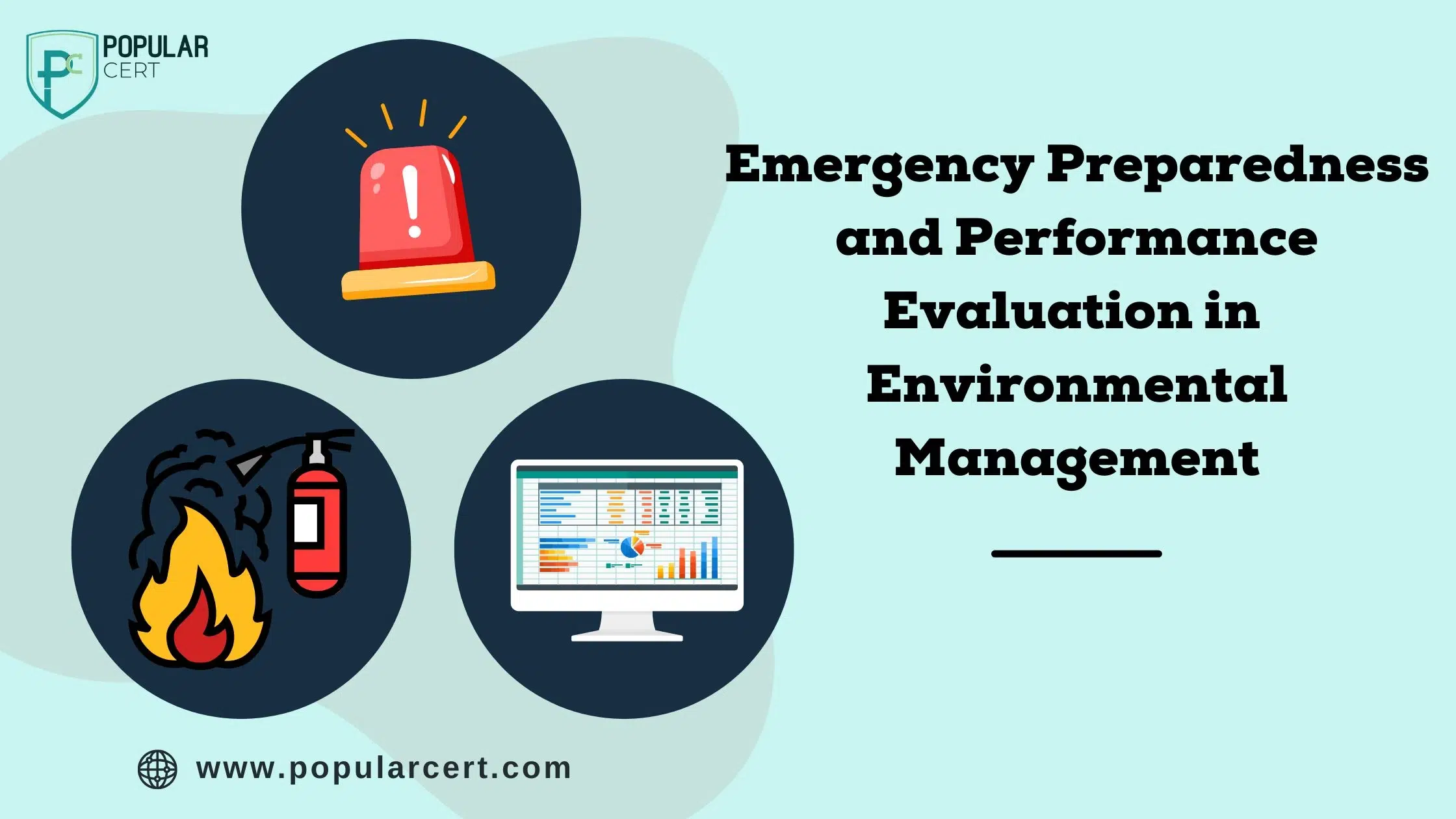Emergency Preparedness and Performance Evaluation in Environmental Management

Effective environmental management requires organizations to be prepared for emergency situations and consistently evaluate their performance. Clause 8.2 (Emergency Preparedness and Response) of ISO 14001 emphasizes the need for organizations to identify potential environmental emergencies, establish response plans, and implement corrective measures. Meanwhile, Clause 9.1 (Monitoring, Measurement, Analysis and Evaluation) focuses on assessing environmental performance through systematic data collection and analysis. Together, these elements ensure organizations minimize environmental risks and continuously improve their sustainability efforts
Clause 8.2: Emergency preparedness and response
In preparing a response to an emergency situation, consideration should be given to the initial environmental impact that can result and any secondary impact that can occur as a result of responding to the initial environmental impact. For example, in responding to a fire, the potential for air pollution should be considered.
When preparing a response to reasonably foreseeable emergency situations, special attention should be paid to start-up and shutdown and abnormal operating conditions.
An organization should be prepared for different types of situations, such as small-scale spillages of chemicals, failure of emission abatement equipment or serious environmental situations endangering humans and environment to a broad extent. The organization should be prepared for each type of reasonably foreseeable emergency situation.
Emergency preparedness and response
The organization shall establish, implement and maintain the processes needed to prepare for and respond to potential emergency situations.
The organization shall:
- Prepare to respond by planning actions to prevent or mitigate adverse environmental impacts from emergency situations.
- Respond to actual emergency situations.
- Take action to prevent or mitigate the consequences of emergency situations, appropriate to the magnitude of the emergency and potential environmental impact.
- Periodically test the planned response actions, where practicable.
- Periodically review and revise the process(es) and planned response actions, in particular after the occurrence of emergency situations or tests.
- Provide relevant information and training related to emergency preparedness and response, as appropriate, to relevant interested parties, including persons working under its control.
The organization shall maintain documented information to the extent necessary to have confidence that the process(es) is (are) carried out as planned.
It is the responsibility of each organization to establish emergency preparedness and response plans that suit its own particular needs. In establishing its plans, the organization should include consideration of:
- Actual and potential external environmental conditions, including natural disasters.
- The nature of on-site hazards, eg. flammable liquid, storage tanks, compressed gases and measures to be taken in the event of spillages or accidental releases.
- The most likely type and scale of an emergency situation or accident.
- Equipment and resources needed.
- The potential for emergency situations at a nearby facility (eg. plant, road, railway line).
- The most appropriate methods for responding to an emergency situation.
- The actions required to minimize environmental damage.
- Emergency organization and responsibilities.
- Evacuation routes and assembly points.
- A list of key personnel and aid agencies, including contact details, e.g. fire department and spillage clean-up services.
- The possibility of mutual assistance from neighboring organizations.
- Internal and external communication processes.
- Mitigation and response actions to be taken for different types of emergency situation(s).
- Processes for a post-emergency evaluation, including evaluation of the planned response, to establish and implement corrective and preventive actions.
- Periodic testing of emergency response procedures.
- Information on hazardous materials, including each material’s potential impact on the environment, and measures to be taken in the event of accidental release.
- Training or competency requirements, including those for emergency response personnel and testing its effectiveness.
In planning for emergency preparedness, the links with other management systems relating to business continuity and occupational health and safety can be considered.
The organization should maintain documented information to the extent necessary, in order to have confidence that the processes needed for emergency preparedness and response are carried out as planned.
Types Of Certification
- ISO Certification
- ISO 9001 Certification
- ISO 14001 Certification
- ISO 45001 Certification
- ISO 22000 Certification
- ISO 27001 Certification
- ISO 17025 Certification
- ISO 13485 Certification
- ISO 20000-1 Certification
- ISO 22301 Certification
- ISO 50001 Certification
- ISO 37001 Certification
- IATF 16949 Certification
- ISO 29001 Certification
- ISO 31000 Certification
- ISO 20121 Certification
- ISO 10002 Certification
- ISO 41001 Certification
Get Free Consultation
Our Clients


















Clause 09: Performance Evaluation
Clause 9.1: Monitoring, measurement, analysis and evaluation
9.1.1 General
An organization should have a systematic approach for monitoring, measurement, analysis and evaluation of its environmental performance on a regular basis. This can enable the organization to report and communicate accurately on its environmental performance.
Monitoring generally refers to processes where observations are made over time, without necessarily using monitoring equipment. Measurement generally refers to processes where equipment is typically used to determine quantitative or qualitative properties. Measurement therefore can imply the need for additional controls to ensure the sustained reliability of such equipment (e.g. calibration), where appropriate.
An organization should determine what needs to be monitored and measured taking into account its environmental objectives, significant environmental aspects, compliance obligations and operational controls. This should include determining the frequency and the methods used to collect the data.
In order to focus its resources on the most important measurements, the organization should select relevant indicators that are easy to understand and that provide useful information for evaluation of its environmental performance. The selection of indicators should reflect the nature and scale of the organization’s operations and be appropriate to its environmental impacts. Examples of indicators include physical parameters, such as temperatures. pressures, pH and material usage, energy efficiency, choice of packaging and transportation.
Monitoring and measuring can serve many purposes in an environmental management system, such as:
- Tracking progress on achieving environmental policy commitments and environmental objectives and continual improvement.
- Providing information to identify significant environmental aspects.
- Collecting data on emissions and discharges to fulfil compliance obligations.
- Collecting data on use of water, energy or raw materials to achieve environmental objectives.
- Providing data to support or evaluate operational controls.
- Providing data to evaluate the organization’s environmental performance.
- Providing data to evaluate the performance of the environmental management system.
Monitoring and measuring should be conducted under controlled conditions with appropriate processes for assuring the validity of results, such as:
- Selecting sampling and data collection techniques.
- Providing adequate calibration or verification of measuring equipment.
- Measuring standards traceable to international or national measuring standards.
- Use of competent personnel.
- Use of suitable quality control methods that includes data interpretation and trend analysis.
Organizations should consider, where appropriate, using laboratories whose testing techniques have been either accredited by a national accreditation body or approved by the regulators. If accreditation or approval is not possible or available, then the organization can consider other suitable methods to verify the accuracy of results, such as split sample analysis, testing of certified reference materials and proficiency test programmes.
The results of monitoring and measuring should be analyzed and used to identify nonconformity, adherence to limits specified by compliance obligations, performance trends and opportunities for continual improvement. Data analysis can include consideration of the data quality, validity, adequacy and completeness necessary to produce reliable information.
Statistical tools can be used to increase the reliability of decisions on whether or not a desired result was achieved. These tools can include, as appropriate, graphical techniques, indexing, aggregating or weighting.
Written procedures for conducting monitoring, measurement, analysis and evaluation can help to provide consistency, reproducibility and reliability of the data produced. The results of monitoring, measurement analysis and evaluation should be retained as documented information.
Conclusion
Emergency preparedness and performance evaluation are essential components of an effective environmental management system. By proactively planning for emergencies and continuously assessing environmental performance, organizations can achieve regulatory compliance, enhance sustainability and reduce operational risks.
Get Certified Today
Boost your organization’s credibility with ISO 14001 certification! PopularCert provides expert guidance to help you achieve environmental compliance and business success. Get in touch with us today to get started!
GET A FREE CONSULTATION NOW
FAQ
Why is emergency preparedness important in environmental management?
Emergency preparedness helps organizations prevent environmental damage, protect human health and ensure regulatory compliance during crises such as spills, fires and equipment failures.
How often should an organization review its emergency response plan?
It is recommended to review and test emergency response plans periodically — at least annually or after any major incident — to ensure their effectiveness.
What are the key performance indicators (KPIs) for monitoring environmental performance?
Common KPIs include energy consumption, carbon emissions, waste reduction, water usage and compliance with environmental regulations.
